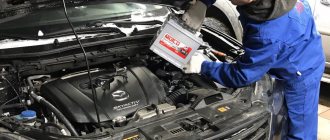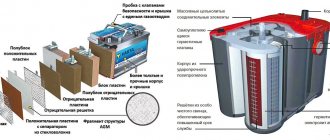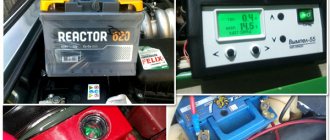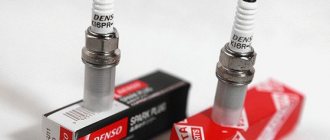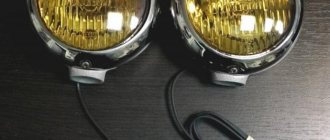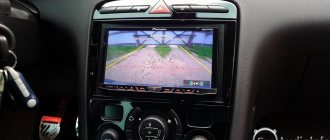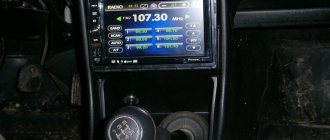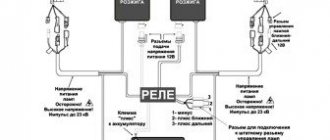The battery in a car is replaced every 3–5 years. In addition, you may need to remove the battery to recharge and reinsert it into the vehicle. A simple procedure, and every driver is confident that he knows how to install the battery in the car. But not everyone knows how to do it correctly. In what sequence should the battery terminals be connected so as not to damage the battery and on-board electronics? And very few people know how to save the settings of their car’s electronic devices.
Necessary tool
You will need two keys in total:
- 10 for tightening the clamp connectors.
- 13 or 14 (depending on the design of the car) - to tighten the battery fastening.
It is better to use not open-end wrenches, but ring or tubular ("heads") . With conventional wrenches, the force on the nut or bolt head is transmitted along only two surfaces. If it is difficult to loosen or tighten (and this is possible, since hardware is used in humid and hot conditions), there is a risk of damaging the nut or bolt. This will result in a certain problem.
You should also keep in mind that with the European method of fixing the battery, you will need a long tubular wrench, since the fastening is done by the “skirt” in the lower part of the battery, where you still need to reach.
Attaching the battery to the bottom protrusion.
What happens if you connect the wires incorrectly?
This situation is called a polarity reversal, and the level of consequences of such an error can vary.
The most negative option is if you connected the wires in the wrong order while the engine is running. Any outcome is possible here: from a blown fuse to failure of the on-board electronics (first of all, the diode bridge of the generator burns out, but all consumers turned on at that moment can suffer - from the radio to the ECU).
The faster you react, the less damage there will be. If you observe active sparking during connection, try to immediately disconnect this terminal.
If you leave everything as is, the wires begin to get very hot and melt, which can cause a fire.
Battery preparation
Before connecting, make sure that the battery is fully charged. There is no point in hoping that the battery will be recharged while driving, especially if you have to travel around the city. If the idle voltage is below 12.6 volts, you need to charge the battery. It also doesn’t hurt to check the level and density of the electrolyte after charging.
Multimeter in battery voltage measurement mode.
If the battery is not new, it will not be superfluous to carry out a control and training cycle. The CTC is needed to know exactly the condition of the battery and to be sure that it will not fail at the most unexpected moment.
If everything is in order, before installation you need to inspect the battery for damage to the case and its cleanliness. Contaminants must be washed off, as they can cause current leakage. To do this, the battery must be wiped with a dry napkin or cloth, and the remaining residue must be washed off using detergents and the battery must be allowed to dry completely. Plaque on the terminals is removed mechanically or chemically (using a paste of water and baking soda).
Cleaning the terminal chemically.
How to connect the battery in a car: plus or minus
Before connecting the battery to the car, you must first make sure that it is fully charged. It is necessary to make sure that the battery case is intact, without cracks or swelling. Before installation, the battery must be wiped with a solution of baking soda, neutralizing microdoses of acid and creating an insulating layer. If the battery terminals are coated with plaque, they need to be cleaned with a toothbrush and baking soda solution. Conductive lubricant is applied to the contact points of the leads.
The socket in which the battery is installed must match the form factor of the battery. It is necessary to use additional latches and brackets so that the case sits on the base like a glove. This will prevent the battery from overturning when driving over bumps, and the electrolyte will not spill.
The battery has 2 terminals, positive and negative. You should connect the battery in the car carefully. How to assemble the circuit correctly, in what sequence? It is safe to connect the positive contacts first, the red wire is used as standard. But each time you need to check the contacts additionally, according to the terminal markings. True, the manufacturers are on the safe side; they make the contacts with different cross-sections so that the wrong terminal is not put on.
The negative contact is always connected last and removed first, so as not to create a short circuit to ground. It is important to tighten the fasteners until they lock into place. Any loosening of the contacts will lead to heating of the area due to resistance. During the period of starting the motor, a starting current passes through the line, many times greater than the numerical value of the capacitance. When connecting the battery, all on-board consumers must be turned off and the ignition key must be removed from the socket.
Installation and fastening of the battery
The battery must be placed on the landing tray - the same way the old battery was. When choosing a battery, you need to pay attention to the mounting method:
- in European-designed cars, the battery is attached to a protrusion in the lower part of the body;
- for Asian and domestic cars - with the bar on top.
The second method is more universal; it can be used to fix almost any battery.
If the car is equipped with a mounting bracket, it makes sense to replace the nuts with wing nuts in order to carry out installation or dismantling operations without a wrench in the future.
Fixing the battery using the top bar.
The battery must be installed with correct polarity - so that the negative terminal is on the side of the black wire, and the positive terminal is on the red side. Otherwise, it will be almost impossible to connect the installed battery correctly. Then you need to tighten the nuts securely, but without excessive force.
How to remove and install correctly
The battery must be installed after charging or purchasing a new battery. This process can be very simple, or it can cause some difficulties.
The battery has a significant weight, several tens of kilograms, so holding it suspended with outstretched arms will not work for long. Therefore, you need to think in advance about the sequence of actions, how to remove and how to put the battery in the car. You should prepare the compartment where the battery will be installed. Remove the battery mounting bracket and move the wires with terminals to the side. On some cars, it is necessary to additionally remove adjacent parts. For example, on a Ford Kuga you need to unfasten and remove the front wall of the plastic box in order to slide the battery into the compartment on the side. And on this wall there is a bracket for fastening nearby wires and cables. First, the bracket is unfastened and moved to the side, and then the front wall of the box is removed. In general, you need to prepare the compartment so that nothing prevents you from freely placing the battery in the car.
On some cars, the battery box is located behind the engine, near the partition of the engine compartment. In this case, you will first have to lift the battery from the floor above the engine compartment and place it in a suitable place in the compartment. Then grab the battery handles with your hands and push it into the designated box. To do this, you need to determine a location for the battery. After all, a heavy battery can easily break off plastic and even weak metal parts.
After installing the battery in the compartment, it must be secured with a special bracket or clamp, unless the wires connecting to the battery interfere with this. In some cases, the wires or one of them are connected first.
Expert opinion
Alexey Bartosh
Specialist in repair and maintenance of electrical equipment and industrial electronics.
Ask a Question
It is important that the height of the newly installed battery matches the previous one. Batteries of even the same capacity can have different heights - from 175 to 250 mm. If the battery is slightly lower and the clamp does not clamp it, you can put a spacer under it of the required height. But not on the battery cover. If the gasket is of a small area, it may push through the lid. If the battery is not much higher, it will be more difficult to find a solution, but it is possible. For example, install thread extensions, or use internally threaded bolts instead of nuts. You may have to modify the bracket or even make a new one.
But still, this problem is also solvable. You just need to try to maintain the ability to use brackets and accessories when returning to batteries with the same dimensions.
When buying a new battery and returning the old one, it becomes necessary to remove the old one from the store, only then install a new one. But at the same time, the settings of the car’s electronic devices are lost: the electronic control unit (ECU), data on average mileage and consumption, on-board clock, navigation, etc. There is a need to enter passwords and make new settings. Here the question arises: is it possible to remove the battery from a car with the engine running? What dangers does this pose?
Important! When the power is turned off, the settings of the radio and on-board computer are reset. At the same time, in many radio models you will have to enter a PIN code, if you are the first owner - it should be indicated in the user manual or on a separate card from the kit. If you do not have the code for the radio, you will have to contact the service to unlock it.
The battery is a fairly powerful current consumer. With a charge current of 7 amperes, this will be about 100 W (7A x 14 V). If, when removing the battery from the car, the remaining current consumers were turned off, the generator will lose the entire load, which will certainly lead to a voltage surge of 2 or more times. For electronic circuits, this may be higher than the critical value and will damage them. For example, most capacitors in electronic components are used at 25 V, which indicates the amount of reserve that manufacturers have included.
To avoid a surge, before removing the battery, it is necessary to turn on the maximum amount of load: headlights with low and high beams, fog lights, radio, interior interior lighting, etc. In total, this can amount to more than 200 W of load. And then disconnecting the battery will not lead to a big jump. Then the risk of damage to electronic circuits will be minimal, but theoretically it will still remain. Sparking can produce high-frequency amplitude harmonics, which theoretically can also damage electronics. To avoid sparking, it is useful to coat the battery leads and terminals with a conductive lubricant. If the battery has been charged and current consumption is minimal, then the risk will be even less.
Connecting the battery while the engine is running will only increase the load on the generator and will not create a reason for a voltage surge.
Terminal connections
From a galvanic point of view, the order in which the battery terminals are connected does not matter. If both wires are not connected to the battery, the consumers will not be powered. There is an opinion that if you connect the negative terminal (conductor in black insulation) first, then the positive (red) wire may touch the housing and a short circuit will occur. Actually this is not true. A short circuit will not occur because there is no voltage yet at the positive terminal from the on-board network.
The real danger when connecting (when the minus is connected, and the plus is thrown on and clamped with a key) is that the tool touches the positive terminal and the housing at the same time. In this case, a short circuit cannot be avoided.
Therefore, it makes sense to connect the order when the red wire is connected first, and only then the minus . When doing the reverse order, you just need to be extremely careful.
This applies, naturally, to the case when the battery is removed and installed with the engine off. If the engine is running, the on-board network is powered by the generator, and touching the positive wire to the housing will cause a short circuit. But running a car engine without a connected battery is extremely undesirable, so this option is rare.
The video shows the installation of the Quick-Clamp Terminal.
Procedure for removing the battery
Modern cars contain many electronic devices. If the battery is disconnected, the on-board computer system may malfunction. To avoid this, you can connect a portable charger before removing the battery, which will provide power to the on-board network. The sequence of actions should be like this:
- Remove the key from the ignition.
- Pause for 10-15 minutes. This is the time during which the airbags are still active.
- Loosen the nut with a 10 mm wrench and remove the wire from the negative terminal. This is usually the black wire.
- Remove the red positive wire.
- Using a 12 or 13 mm socket wrench, unscrew the nuts on the rods that hold the pressure plate and remove it.
- Carefully remove the battery.
Now you can begin installing the new battery. Before connecting the battery to the car, you need to remove debris from the shelf and clean the contacts that have oxidized during battery operation.
What to do in unusual situations
Not everything always goes smoothly and according to instructions. Metals tend to corrode and break down. Batteries age and lose their lifespan. Even if you do everything according to the instructions, it is not a fact that there will be no problems when installing the battery.
Rusted mount
The fasteners may rust, and it may not be possible to loosen (tighten) the screws right away. This problem will most likely make itself felt when you remove the battery, but not always. If enough time has passed between dismantling and installation, then you may encounter difficulties when installing the battery. There is no need to apply excessive force here - you can “lick” the edges of the stuck nut, then the problem will only worsen. It is best to use chemical methods.
How to connect an amplifier in a car to a battery
For some time now, car radios have become an indispensable component. For optimal power supply, the device is connected directly to the battery. This allows you to listen to music while the engine is off. But you need to understand that if a leak occurs, the radio can discharge the battery to zero.
For a powerful and clear sound of music, an amplifier is used that uses the energy of the battery, increasing it to the required parameters. The amplifier's power is connected to the battery through a copper cable with a fuse designed for the current strength.
The wires to the location (usually in the trunk) are laid in a corrugated tube. A fuse is mounted to the positive wire, and the negative contact is shorted to ground. The radio and amplifier are connected by an interconnect cable.
In what order should the battery terminals be connected after charging?
It is recommended to fully charge the battery once or twice a year, even if it is not very discharged. This procedure allows you to restore the battery capacity, thereby extending its life. Full charging is carried out in stationary conditions using a charger.
The battery is removed in exactly the same order as when replacing it. During charging, the sequence of connecting the terminals is the same: first the positive wire is connected, on the charger it is also red, then the negative one. The charging process itself depends on both the charger used and the condition of the battery; the instructions for the device describe all possible operating modes.
How to restore settings after connecting the battery
In some cars, after reconnecting the battery, the settings of the on-board computer, car radio, other electronic devices and additional equipment are reset. An error message may appear on the dashboard.
In this case, you need to connect the car to a diagnostic scanner, read and delete all errors. As a rule, errors associated with low voltage on-board network will then be deleted. Other settings, such as car radios, will have to be restored manually.
Still have questions about installing the battery or have something to add? Then write to us about it in the comments, this will make the material more useful, complete and accurate.
Algorithm for correct installation of a car battery
Most motorists, when problems arise with electrical equipment, prefer to contact specialists. And only when manipulating the battery do we try to do everything ourselves, forgetting that this is also an electrical device, and with currents that pose a danger to humans. Considering that when working with a battery we are faced with an aggressive liquid, it would be useful to know the rules for dismantling and reinstalling the battery on a car, taking into account safety requirements that most drivers do not adhere to.
Preparing to remove the battery
The need to remove and install the battery may arise for several reasons: replacement with a new battery, the need for charging, installation of new electrical equipment, repair of components that are difficult to access if the battery is installed. When replacing an old battery with a new one, you need to pay attention to the location of the terminals. It differs for different types of machines. You should choose a new battery with the same pole arrangement as the old one, otherwise the wires may not reach the terminals.
Before starting work, you should prepare the following tools:
Before removing, you need to carefully inspect the battery for broken seals, cracks or stains on the surface. The electrolyte, which is located in the battery, contains a solution of sulfuric acid and causes burns if it comes into contact with the skin.
When working with damaged batteries, you need to wear rubber gloves, and if the skin is damaged, neutralize the acid with a solution of baking soda.
Battery care to increase service life
For long-term and uninterrupted operation of the battery, proper care is required. It consists of cleaning the battery and terminals from dust and moisture, and removing dirt from the ventilation holes. Treatment of fasteners with anti-corrosion agents.
With proper care and proper use, the battery will last a long time and will not require replacement. The main thing is to monitor the condition of the equipment and be especially careful when replacing and installing it.
Learn how to double your battery life in this video:
After you adhere to all these rules and recommendations, choosing and replacing a battery will not be difficult for you. You should not try to avoid this procedure, as it may make further operation of the vehicle easier. After all, failure to comply with the requirements can lead to incorrect operation of your car, and any malfunction during its operation can cause an emergency situation.
Tips from the professionals
- Work on replacing batteries must be carried out in an open space where the accumulation of harmful gases is impossible.
- Before removing the battery, the ignition key must be turned to the zero position or removed from the lock.
- An old battery may be damaged, and inside it there is nothing more than diluted sulfuric acid, so special dielectric gloves and safety glasses must be used.
- It is advisable to remove rings and bracelets from your hands.
- The wires should be located as far as possible from the battery.
- Do not tilt or turn the battery over.
- Do not damage the filler plugs or neck.
- Do not add acid and store a discharged battery, as this can cause complete failure of the equipment, especially at low temperatures.
Advice! After the battery is connected, you will need to check the operation of the lights. To do this, without starting the engine, you will need to alternately turn on the low and high beam headlights, and also check the alarm system and the operation of the windshield wipers. All these devices must work properly.
Types and design of power supplies
There are the following types of car batteries:
- Lead-acid battery. This power supply consists of a plastic housing with six cells. The body contains lead plates, and each cell is filled with electrolyte in the form of liquid acid.
- Under conditions of proper maintenance and operation, the service life reaches 5 years from the date of purchase.
- Lead non-woven AGM battery. The AGM power source is an advanced lead-acid battery. Thanks to improved characteristics and power, the starting current has increased. The AGM battery has a one-piece closed housing and does not require maintenance. Most often used on electric vehicles.
- Lead-helium battery. In an ordinary lead-acid battery, the acid is in liquid form in the housing. In a lead-helium battery, sulfuric acid and silica change from a liquid to a gel. This invention is suitable for those who need to use the battery in a lying or inclined position due to conditions associated with the design. The power supply is housed in a closed housing and does not require maintenance.
- Traction batteries. The most powerful power source, one of the best as of 2022. Used on electric vehicles. Can continuously supply electrical energy to the electric vehicle and withstand multiple charge and discharge cycles. The traction battery provides voltage from 24 V to 96 V and an electrical charging capacity of up to 1000 Ah. The service life is more than 10 years.
Battery and running engine
The car battery can only be removed with the engine turned off. It is prohibited to dismantle the battery while the engine is running. And it is important to take this into account when we are talking about modern cars equipped with on-board computers.
Basic moments:
- When the engine is turned on, a charge is constantly supplied from the generator. When dismantling, the positive terminal hits the body, resulting in a short circuit. This can harm not only the generator, but also the entire wiring and on-board network.
- If the battery is disconnected without permission, a voltage surge occurs. Increased voltage affects the performance of the relay regulator, alarm system, and other components.
- The power source is turned off when the ignition is turned off.
- Dismantling is carried out in accordance with the requirements and standards that are recorded in the technical documentation.
